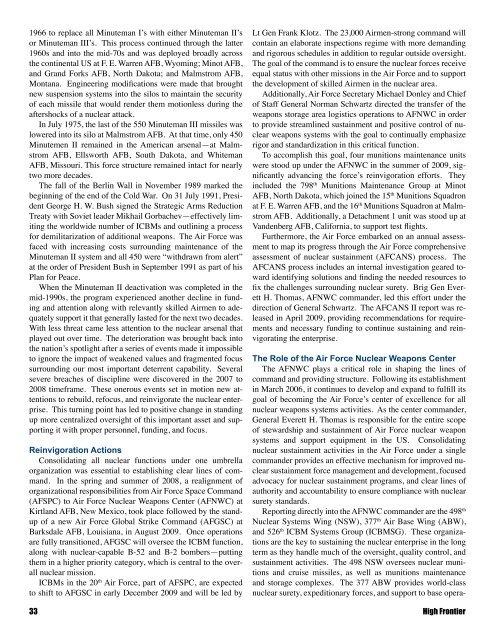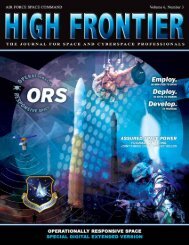Space Acquisition - Air Force Space Command
Space Acquisition - Air Force Space Command
Space Acquisition - Air Force Space Command
Create successful ePaper yourself
Turn your PDF publications into a flip-book with our unique Google optimized e-Paper software.
1966 to replace all Minuteman I’s with either Minuteman II’s<br />
or Minuteman III’s. This process continued through the latter<br />
1960s and into the mid-70s and was deployed broadly across<br />
the continental US at F. E. Warren AFB, Wyoming; Minot AFB,<br />
and Grand Forks AFB, North Dakota; and Malmstrom AFB,<br />
Montana. Engineering modifications were made that brought<br />
new suspension systems into the silos to maintain the security<br />
of each missile that would render them motionless during the<br />
aftershocks of a nuclear attack.<br />
In July 1975, the last of the 550 Minuteman III missiles was<br />
lowered into its silo at Malmstrom AFB. At that time, only 450<br />
Minutemen II remained in the American arsenal—at Malmstrom<br />
AFB, Ellsworth AFB, South Dakota, and Whiteman<br />
AFB, Missouri. This force structure remained intact for nearly<br />
two more decades.<br />
The fall of the Berlin Wall in November 1989 marked the<br />
beginning of the end of the Cold War. On 31 July 1991, President<br />
George H. W. Bush signed the Strategic Arms Reduction<br />
Treaty with Soviet leader Mikhail Gorbachev—effectively limiting<br />
the worldwide number of ICBMs and outlining a process<br />
for demilitarization of additional weapons. The <strong>Air</strong> <strong>Force</strong> was<br />
faced with increasing costs surrounding maintenance of the<br />
Minuteman II system and all 450 were “withdrawn from alert”<br />
at the order of President Bush in September 1991 as part of his<br />
Plan for Peace.<br />
When the Minuteman II deactivation was completed in the<br />
mid-1990s, the program experienced another decline in funding<br />
and attention along with relevantly skilled <strong>Air</strong>men to adequately<br />
support it that generally lasted for the next two decades.<br />
With less threat came less attention to the nuclear arsenal that<br />
played out over time. The deterioration was brought back into<br />
the nation’s spotlight after a series of events made it impossible<br />
to ignore the impact of weakened values and fragmented focus<br />
surrounding our most important deterrent capability. Several<br />
severe breaches of discipline were discovered in the 2007 to<br />
2008 timeframe. These onerous events set in motion new attentions<br />
to rebuild, refocus, and reinvigorate the nuclear enterprise.<br />
This turning point has led to positive change in standing<br />
up more centralized oversight of this important asset and supporting<br />
it with proper personnel, funding, and focus.<br />
Reinvigoration Actions<br />
Consolidating all nuclear functions under one umbrella<br />
organization was essential to establishing clear lines of command.<br />
In the spring and summer of 2008, a realignment of<br />
organizational responsibilities from <strong>Air</strong> <strong>Force</strong> <strong>Space</strong> <strong>Command</strong><br />
(AFSPC) to <strong>Air</strong> <strong>Force</strong> Nuclear Weapons Center (AFNWC) at<br />
Kirtland AFB, New Mexico, took place followed by the standup<br />
of a new <strong>Air</strong> <strong>Force</strong> Global Strike <strong>Command</strong> (AFGSC) at<br />
Barksdale AFB, Louisiana, in August 2009. Once operations<br />
are fully transitioned, AFGSC will oversee the ICBM function,<br />
along with nuclear-capable B-52 and B-2 bombers—putting<br />
them in a higher priority category, which is central to the overall<br />
nuclear mission.<br />
ICBMs in the 20 th <strong>Air</strong> <strong>Force</strong>, part of AFSPC, are expected<br />
to shift to AFGSC in early December 2009 and will be led by<br />
Lt Gen Frank Klotz. The 23,000 <strong>Air</strong>men-strong command will<br />
contain an elaborate inspections regime with more demanding<br />
and rigorous schedules in addition to regular outside oversight.<br />
The goal of the command is to ensure the nuclear forces receive<br />
equal status with other missions in the <strong>Air</strong> <strong>Force</strong> and to support<br />
the development of skilled <strong>Air</strong>men in the nuclear area.<br />
Additionally, <strong>Air</strong> <strong>Force</strong> Secretary Michael Donley and Chief<br />
of Staff General Norman Schwartz directed the transfer of the<br />
weapons storage area logistics operations to AFNWC in order<br />
to provide streamlined sustainment and positive control of nuclear<br />
weapons systems with the goal to continually emphasize<br />
rigor and standardization in this critical function.<br />
To accomplish this goal, four munitions maintenance units<br />
were stood up under the AFNWC in the summer of 2009, significantly<br />
advancing the force’s reinvigoration efforts. They<br />
included the 798 th Munitions Maintenance Group at Minot<br />
AFB, North Dakota, which joined the 15 th Munitions Squadron<br />
at F. E. Warren AFB, and the 16 th Munitions Squadron at Malmstrom<br />
AFB. Additionally, a Detachment 1 unit was stood up at<br />
Vandenberg AFB, California, to support test flights.<br />
Furthermore, the <strong>Air</strong> <strong>Force</strong> embarked on an annual assessment<br />
to map its progress through the <strong>Air</strong> <strong>Force</strong> comprehensive<br />
assessment of nuclear sustainment (AFCANS) process. The<br />
AFCANS process includes an internal investigation geared toward<br />
identifying solutions and finding the needed resources to<br />
fix the challenges surrounding nuclear surety. Brig Gen Everett<br />
H. Thomas, AFNWC commander, led this effort under the<br />
direction of General Schwartz. The AFCANS II report was released<br />
in April 2009, providing recommendations for requirements<br />
and necessary funding to continue sustaining and reinvigorating<br />
the enterprise.<br />
The Role of the <strong>Air</strong> <strong>Force</strong> Nuclear Weapons Center<br />
The AFNWC plays a critical role in shaping the lines of<br />
command and providing structure. Following its establishment<br />
in March 2006, it continues to develop and expand to fulfill its<br />
goal of becoming the <strong>Air</strong> <strong>Force</strong>’s center of excellence for all<br />
nuclear weapons systems activities. As the center commander,<br />
General Everett H. Thomas is responsible for the entire scope<br />
of stewardship and sustainment of <strong>Air</strong> <strong>Force</strong> nuclear weapon<br />
systems and support equipment in the US. Consolidating<br />
nuclear sustainment activities in the <strong>Air</strong> <strong>Force</strong> under a single<br />
commander provides an effective mechanism for improved nuclear<br />
sustainment force management and development, focused<br />
advocacy for nuclear sustainment programs, and clear lines of<br />
authority and accountability to ensure compliance with nuclear<br />
surety standards.<br />
Reporting directly into the AFNWC commander are the 498 th<br />
Nuclear Systems Wing (NSW), 377 th <strong>Air</strong> Base Wing (ABW),<br />
and 526 th ICBM Systems Group (ICBMSG). These organizations<br />
are the key to sustaining the nuclear enterprise in the long<br />
term as they handle much of the oversight, quality control, and<br />
sustainment activities. The 498 NSW oversees nuclear munitions<br />
and cruise missiles, as well as munitions maintenance<br />
and storage complexes. The 377 ABW provides world-class<br />
nuclear surety, expeditionary forces, and support to base opera-<br />
33 High Frontier











